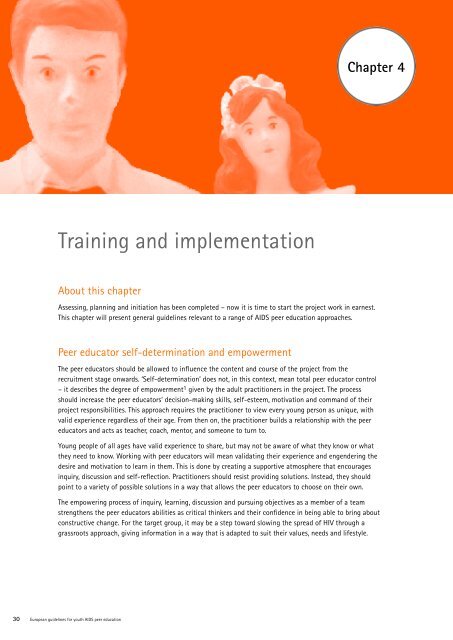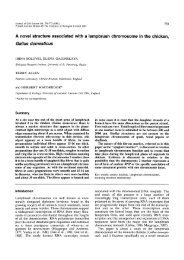European guidelines for youth AIDS peer education - University of ...
European guidelines for youth AIDS peer education - University of ...
European guidelines for youth AIDS peer education - University of ...
- No tags were found...
You also want an ePaper? Increase the reach of your titles
YUMPU automatically turns print PDFs into web optimized ePapers that Google loves.
Chapter 4Training and implementationAbout this chapterAssessing, planning and initiation has been completed – now it is time to start the project work in earnest.This chapter will present general <strong>guidelines</strong> relevant to a range <strong>of</strong> <strong>AIDS</strong> <strong>peer</strong> <strong>education</strong> approaches.Peer educator self-determination and empowermentThe <strong>peer</strong> educators should be allowed to influence the content and course <strong>of</strong> the project from therecruitment stage onwards. ‘Self-determination’ does not, in this context, mean total <strong>peer</strong> educator control– it describes the degree <strong>of</strong> empowerment 1 given by the adult practitioners in the project. The processshould increase the <strong>peer</strong> educators’ decision-making skills, self-esteem, motivation and command <strong>of</strong> theirproject responsibilities. This approach requires the practitioner to view every young person as unique, withvalid experience regardless <strong>of</strong> their age. From then on, the practitioner builds a relationship with the <strong>peer</strong>educators and acts as teacher, coach, mentor, and someone to turn to.Young people <strong>of</strong> all ages have valid experience to share, but may not be aware <strong>of</strong> what they know or whatthey need to know. Working with <strong>peer</strong> educators will mean validating their experience and engendering thedesire and motivation to learn in them. This is done by creating a supportive atmosphere that encouragesinquiry, discussion and self-reflection. Practitioners should resist providing solutions. Instead, they shouldpoint to a variety <strong>of</strong> possible solutions in a way that allows the <strong>peer</strong> educators to choose on their own.The empowering process <strong>of</strong> inquiry, learning, discussion and pursuing objectives as a member <strong>of</strong> a teamstrengthens the <strong>peer</strong> educators abilities as critical thinkers and their confidence in being able to bring aboutconstructive change. For the target group, it may be a step toward slowing the spread <strong>of</strong> HIV through agrassroots approach, giving in<strong>for</strong>mation in a way that is adapted to suit their values, needs and lifestyle.30 <strong>European</strong> <strong>guidelines</strong> <strong>for</strong> <strong>youth</strong> <strong>AIDS</strong> <strong>peer</strong> <strong>education</strong>
















